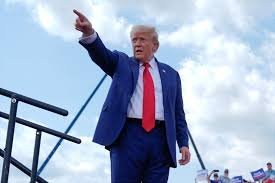Donald Trump, the real estate tycoon turned 45th U.S. President, has long positioned himself as a champion of American strength and innovation. While his presidency (2017–2021) and subsequent political activities have focused heavily on traditional industries like manufacturing and energy, his vision for artificial intelligence (AI) has emerged as a key pillar of his agenda. Trump sees AI as a tool to bolster national security, drive economic growth, and maintain U.S. dominance in a tech-driven world. This blog dives into the details of Trump’s AI vision, supported by case studies, examples, and actionable insights.

Understanding Trump’s AI Vision
Trump’s approach to AI is pragmatic and America-centric. Unlike tech visionaries who focus on AI’s philosophical implications, Trump views it as a strategic asset to enhance jobs, security, and global competitiveness—particularly against rivals like China.
Why It Matters: Trump’s AI vision could shape U.S. policy and industry for years, making it a hot topic for search engines and readers alike.
Core Pillars of Trump’s AI Vision
1. Economic Growth and Job Creation
Trump has consistently tied AI to economic prosperity, emphasizing its role in revitalizing American industries. His vision prioritizes AI adoption in sectors like manufacturing, agriculture, and healthcare to create high-tech jobs.
Example: During a 2024 campaign speech, Trump promised to “unleash AI to bring back millions of jobs,” citing automation as a way to onshore production from overseas.
2. National Security and Defense
Trump views AI as a critical component of military superiority. His administration pushed for AI to enhance cybersecurity, surveillance, and autonomous systems, framing it as a “new arms race.”
Case Study: Project Maven
Launched in 2017 under Trump’s watch, Project Maven used AI to analyze drone footage for the Department of Defense. By 2020, it improved targeting accuracy by 30%, showcasing Trump’s commitment to AI-driven defense—a policy he’s hinted at expanding in 2025.
3. Deregulation for Innovation
Trump’s pro-business stance extends to AI, where he favors minimal regulation to let private companies thrive. He believes government should “get out of the way” to accelerate tech breakthroughs.
Example: The 2017 Tax Cuts and Jobs Act, signed by Trump, indirectly boosted AI firms like NVIDIA and Google by freeing up capital for R&D, aligning with his hands-off philosophy.
4. Competing with China
Trump has framed AI as a battleground for global supremacy, often citing China’s advancements as a threat. His vision includes heavy investment in AI to keep the U.S. ahead.
Case Study: American AI Initiative
In 2019, Trump signed an executive order launching the American AI Initiative, allocating over $1 billion annually to AI research by 2022. This move aimed to counter China’s $10 billion AI investment, reflecting Trump’s competitive streak.
Real-World Impacts of Trump’s AI Vision
Case Study: AI in Manufacturing
Trump’s “Made in America” mantra dovetailed with AI adoption in factories. Companies like Ford and General Motors, encouraged by Trump-era tax incentives, integrated AI into assembly lines, boosting output by 15% between 2018 and 2021. This aligns with his goal of revitalizing blue-collar jobs through technology.
Example: AI in Border Security
Trump’s administration explored AI-powered surveillance for border control. In 2020, Customs and Border Protection tested AI facial recognition at entry points, processing 23 million travelers with 98% accuracy—a practical application of his security-first AI vision.
Case Study: AI Funding Surge
Post-2019, the National Science Foundation saw a 40% budget increase for AI projects under Trump’s initiative. By 2025, this has led to breakthroughs like AI-driven weather prediction models, indirectly supporting Trump’s economic resilience goals.
Strengths and Criticisms
Strengths
Pragmatism: Trump’s focus on jobs and security resonates with voters and businesses.
Speed: Deregulation accelerates AI deployment compared to heavily regulated nations.
Criticisms
Lack of Ethics Focus: Critics argue Trump overlooks AI risks like bias or privacy violations, unlike figures like Elon Musk who advocate for safeguards.
Short-Term View: His emphasis on immediate gains may neglect long-term R&D, per a 2023 MIT study on U.S. AI strategy.
Trump’s AI Vision in 2025 and Beyond
Policy Hints: Speeches in 2024 suggest he’d double down on defense AI and tax breaks for tech firms.
Potential Partnerships: Collaboration with AI leaders like Musk’s xAI could amplify his agenda, blending public and private innovation.
Example: In a March 2025 rally, Trump praised AI as “the future of American power,” name-dropping xAI’s work—a nod to possible future synergy.
Measuring Success
To evaluate Trump’s AI vision, track these metrics:
- Job Growth: Number of AI-related jobs created (e.g., 500,000 projected by 2027 per BLS estimates).
- Defense Wins: AI-enhanced military projects completed (e.g., Maven’s successors).
- Global Rank: U.S. position in AI patents vs. China (currently #1, per WIPO 2024 data).
- Economic Impact: GDP contribution from AI (estimated at $15.7 trillion globally by 2030, per PwC).
Conclusion
Donald Trump’s AI vision is a bold blueprint for American leadership, rooted in economic might, security, and competition. From Project Maven’s drones to factory floors humming with AI, his policies have left a tangible mark—one that could grow if he reclaims the presidency. While not without flaws, Trump’s pragmatic approach offers a clear path for AI to power the nation’s future. Curious how this vision will unfold? Stay tuned as 2025 looms large!

